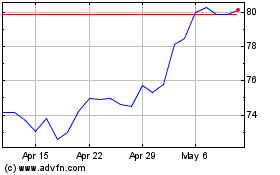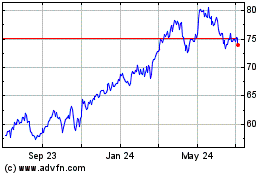Treasury Cuts TARP Cost Estimate After GM, AIG Shares Rise
April 10 2012 - 6:03PM
Dow Jones News
The Treasury Department Tuesday trimmed its cost estimate for
the financial bailout, reflecting rising share prices for two of
the companies it rescued at the height of the crisis.
The Troubled Asset Relief Program, or TARP, will ultimately cost
taxpayers $59.75 billion, Treasury said in a monthly report to
Congress. That is down from the previous estimate of $67.82
billion.
The latest figures are based on General Motors Co. (GM) and
American International Group Inc.'s (AIG) share prices from Feb.
29, while the earlier estimate reflected market values on Nov. 30.
GM stock climbed by about 22% and AIG by almost 32% in the interim.
That adds up to roughly $8 billion in market value that Treasury
can count against TARP's long-term cost.
Of course, what goes up can just as easily come down. Share
prices for AIG and GM have moved in opposite directions since
Treasury made its latest calculation. AIG's shares are up about 9%,
while GM is down nearly 7% as of Monday's close.
More than three year's after TARP's launch, the U.S. still has
substantial investments in AIG, GM, Ally Financial Inc. and
hundreds of smaller banks. The U.S. currently holds a 70% stake in
AIG and a 26.5% stake in GM--the largest of the publicly traded
companies.
Still, the program hasn't been as costly to taxpayers as
originally feared. At one point, the plan's price tag was set at
$700 billion. Ultimately, $431 billion was disbursed through a
handful of programs and much of that has been recovered as
companies paid back funds or the government sold off
investments.
Indeed, some of TARP's components are expected to turn a
profit.
In Treasury's latest estimate, the biggest chunk of costs are
expected to arise from $46 billion set aside for housing--funds
that some think will never be used.
The Congressional Budget Office, for example, expects only $13
billion will eventually be disbursed for mortgage programs. Because
of the big difference, CBO last month forecast that TARP will end
up costing taxpayers $32 billion.
The remaining costs stem largely from assistance to AIG and aid
to the automotive industry.
-By Jeffrey Sparshott; Dow Jones Newswires; 202-862-9291; jeffrey.sparshott@dowjones.com
American (NYSE:AIG)
Historical Stock Chart
From Mar 2024 to Apr 2024

American (NYSE:AIG)
Historical Stock Chart
From Apr 2023 to Apr 2024
